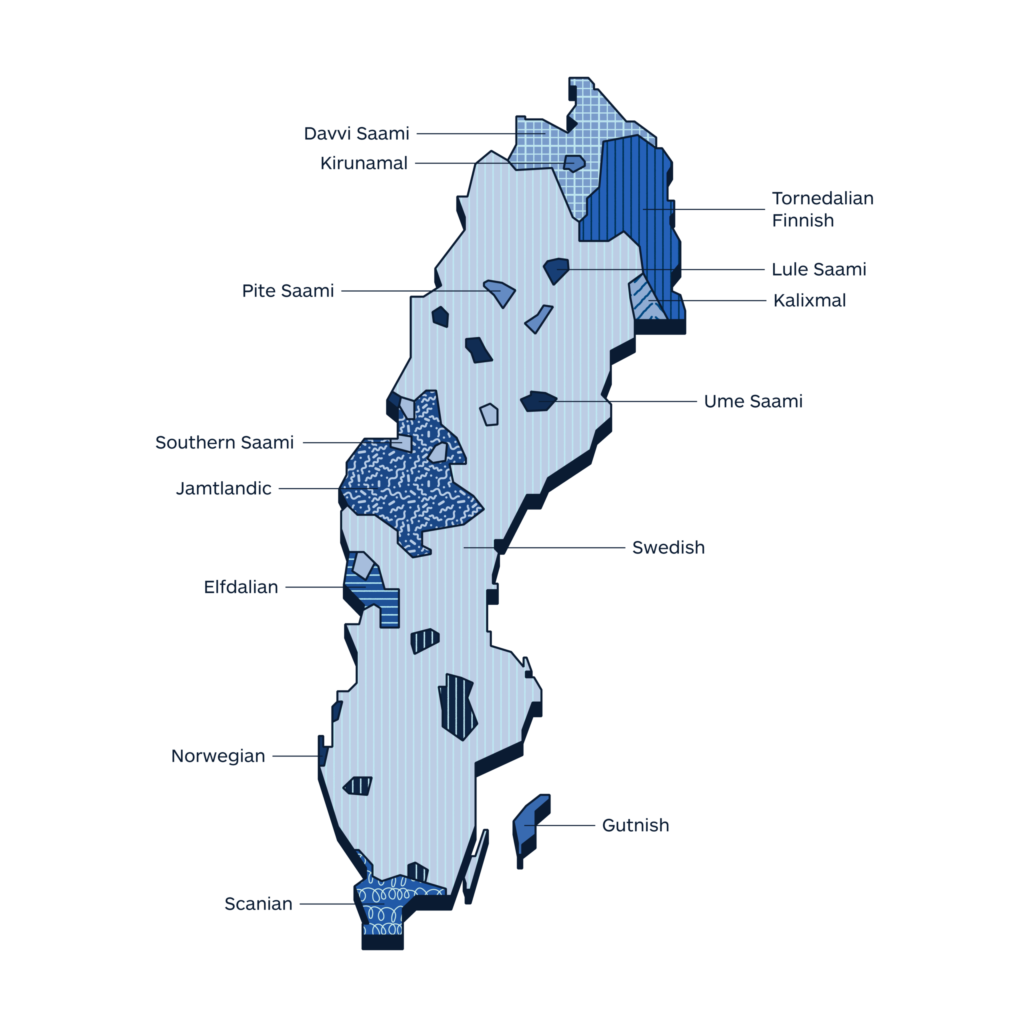Europe
To which language should you translate to localize in Sweden?
What we know from our community
“Sweden speaks one language: Swedish. Even though there are only 10,3 million speakers, there are hundreds of local dialects divided into six major dialects: Norrland, Finland Swedish, Gotland, Götamal, Svealand and Southern Sweden. The differences are quite vast and are in some cases linked to geographic circumstances, with the Southern Swedish being heavily influenced by Danish, with softening consonants, while the dialect in Norrland is believed to stem from the Medieval times. It’s near impossible even for Swedes to comprehend all six major dialects.
There is high English literacy in Sweden, as English is the official second language. Swedes, therefore, have no problems accepting English loanwords but still prefer localised products and content. The Swedish language has moved towards more casual expressions. The formal “ni” (you) has been replaced with the informal “du”. Swedes are also allergic to superlatives and other forms of exaggeration and prefer more direct and factual communication.”
LANGUAGE INSIGHT
Official language
Swedish (89.5%)
Actual languages
Swedish (89.5%), Finnish (3.1%), Arabic (0.8%), Spanish (0.6%), Norwegian (0.5%), other (5.5%)
What the top 150 best localized websites in the world do in Sweden
(Top 150 websites listed in the Global by Design ranking – published annually by Byte Level Research, this report provides a list of globally localized websites, showcasing best practices and emerging trends in their globalization)
- 109/150 localize by translating into Swedish
- 1/150 localizes by translating into Swedish and Swedish Sign Language
- 1/150 localizes by translating into both Swedish and Norwegian (Bokmål)
- 1/150 localizes by translating into both Swedish and French
- 1/150 localizes by translating into Swedish, Italian, German, Spanish, French, Polish, Portuguese, Simplified Chinese, Traditional Chinese, Japanese, Dutch, Czech, Arabic and Hungarian
- 1/150 localizes by translating into German, Spanish, French, Polish, Portuguese and Simplified Chinese
- 1/150 localizes by translating into Italian, German, Spanish, French, Portuguese, Simplified Chinese, Traditional Chinese, Japanese, Korean and Russian
- 1/150 localizes by translating into Italian, German, Spanish, French and Simplified Chinese
- 1/150 localizes by translating into Italian, German, Spanish, French, Polish, Portuguese, Simplified Chinese, Traditional Chinese, Japanese, Hungarian, Russian, Bahasa Indonesia, Romanian, Turkish, Ukrainian and Thai
- 1/150 localizes by translating into Italian
-
3M
-
ABB
-
Accenture
-
Adidas
-
Adobe
-
Airbnb
-
Aldi
-
Amazon
-
American Airlines
-
American Express
-
Apple
-
Audi
-
Autodesk
-
Avis
-
Bayer
-
BMW
-
Booking.com
-
Bosch
-
British Airways
-
Bumble
-
Burberry
-
BYD
-
Canon
-
Capgemini
-
Cartier
-
Caterpillar
-
Chevrolet
-
Cisco Systems
-
Citibank
-
Coca-Cola
-
Costco
-
Dell
-
Deloitte
-
Delta
-
DHL
-
Disney+
-
Dyson
-
eBay
-
Eli Lilly
-
Emirates
-
Ernst & Young
-
Facebook
-
FedEx
-
Ford
-
Four Seasons
-
Fujifilm
-
GE
-
Gillette
-
GoDaddy
-
Google
-
Gucci
-
Haier
-
Heineken
-
Hermès
-
Hertz
-
Hilton
-
Hisense
-
Hitachi
-
Honda
-
Hotels.com
-
HP
-
HP Enterprise
-
HSBC
-
Huawei
-
Hyatt
-
Hyundai
-
IBM
-
IKEA
-
Intel
-
InterContinental Hotels
-
J&J
-
Jack Daniel's
-
Jehovah’s Witnesses
-
John Deere
-
Kellogg's
-
Kia
-
KPMG
-
L'Oréal
-
Land Rover
-
LEGO
-
Lenovo
-
Lexus
-
LG
-
Louis Vuitton
-
Lululemon
-
LUSH
-
Marriott
-
MasterCard
-
McDonald's
-
Mercedes-Benz
-
Merck
-
Microsoft
-
Mitsubishi Electric
-
Nestlé
-
Netflix
-
Nike
-
Nikon
-
Nintendo
-
Nio
-
Nissan
-
NIVEA
-
Oracle
-
Pampers
-
Panasonic
-
PayPal
-
Pepsi
-
Pfizer
-
Philips
-
Pitney Bowes
-
Porsche
-
Procter & Gamble
-
PWC
-
Revolut
-
Rolex
-
Royal Caribbean
-
Salesforce
-
Samsung
-
Sanofi
-
SAP
-
Sephora
-
Shopify
-
Siemens
-
Sony
-
Spotify
-
Starbucks
-
Steelcase
-
Stripe
-
Subaru
-
Tesla
-
The Church of Jesus Christ of Latter-day Saints
-
Tiffany
-
Tinder
-
Toshiba
-
Toyota
-
TripAdvisor
-
Uber
-
United Airlines
-
UPS
-
Visa
-
Volkswagen
-
Volvo Cars
-
Vrbo
-
Walmart
-
Western Union
-
Wikipedia
-
Wise
-
WordPress
-
Workday
-
Xerox
-
Xiaomi (Mi)
-
Zara
-
Zoom
If you need others information, below you can find a selection of economic/social/cultural data
Overview
Language
Official language
Swedish
T-index
0.53%
T-Index ranks countries according to their potential for online sales.
Other languages
Indigenous: Westrobothnian, Elfdalian, Modern Gutnish, Jamtlandic, Scanian.
Regional: Finnish, Meänkieli, Romani, Sami, Yiddish.
Immigrant: Arabic, Serbo-Croatian, Greek, Kurdish, Persian, Polish, Spanish, Somali.
Most studied languages
English 86%, German 30%, French 11%.
English
Very high proficiency (EF) – 6 of 113 countries/regions in the world, 5/34 position in Europe.
Demography
Capital: Stockholm
Currency: Swedish krona
Population: 10,48 m
Population density: 26 /km2
Economy
GDP: 591.71 billion USD (2022)
GDP per capita: 56,424.3 USD (2022)
Exports: $194 billion (2022)
Statistics
Internet users: 98.1% penetration, 10.44 million
Unemployment rate: 7.7% (2023)
Urbanisation: 88.49% (2022)
Literacy: 99% (2024)
Conventions
Numbering system
Arabic numerals and comma as decimal separator
Date format: yyyy-mm-dd / dd-mm-yyyy
Time: 24h time system
Country code: 0046
Language data sources: Worldatlas/Britannica//EF/Wikipedia; Demography data sources: IMF/Worldometers; Conventions data source: Wikipedia; Economy data sources: WTO/OEC/CIA/Esomar/Datareportal; Statistics data sources: Datareportal/WorldBank/UN/UNESCO/CEIC/IMF/Culturalatlas/Commisceoglobal
Facts and data
Economy
Imports
$190 billion (2022). Crude Petroleum ($14.2B), Cars ($9.84B), Refined Petroleum ($8.81B), Broadcasting Equipment ($6.44B), and Motor vehicles; parts and accessories (8701 to 8705) ($5.66B), importing mostly from Germany ($30B), Netherlands ($19.3B), Norway ($17.7B), China ($13.6B), and Denmark ($11.6B).
Financial inclusion factors (over 15 years of age)
• 99.7% have an account with a financial institution
• 45% have a credit card
• 84% make online purchases
Ease of doing business
It is very easy to conduct business (rated 82 out of 100) ranked 7th out of 44 OECD high income countries ranked 10th out of 190 countries worldwide (2019, World Bank).
Global Innovation Index
Ranked 2nd out of 39 European countries, 2nd out of 132 worldwide.
The Global Innovation Index captures the innovation
ecosystem performance of 132 economies and tracks the most recent global innovation trends.
Exports
$194 billion (2022). Refined Petroleum ($12.9B), Cars ($11.9B), Packaged Medicaments ($8.25B), Electricity($5.83B), and Sawn Wood ($4.76B), exporting mostly to Germany ($19.2B), Norway ($18.7B), United States ($17.8B), Denmark ($14.6B), and Finland ($13.4B).
Main local online stores
Ikea.com, Netonnet.se, Elgiganten.se, Webbhallen.com, Zalando.se, Hm.com, Mediamarkt.se, Coop.se, Apotea.se, Sas.se.
Main foreign online stores
Amazon.com, Aliexpress.com, Amazon.co.uk, Amazon.de, Norwegian.com, Asos.com, Etsy.com, Lightinthebox.com, Allegro.pl.
Economic freedom
‘Mostly free’ (rated 77.5 out of 100) ranked 6th out of 44 European countries ranked 9th out of 186 countries worldwide (2024, Heritage Foundation and Wall Street Journal).
Economy data sources: WTO/OEC/CIA/Esomar/Datareportal
Service Imports (2020)
Service Exports (2020)
Source: OEC
Trade balance of goods from 2012 to 2022
Source: Statista
Historical Data Trade Imports (2020)
The following section uses historical trade data imports from partners of Sweden.
Historical Data Trade Exports (2020)
The following section uses historical trade data exports from partners of Sweden.
Source: OEC
The Top Export Opportunities for Sweden by Relatedness
Relatedness measures the distance between a country's current exports and each product by showing only products that Sweden is not specialized in.
Sweden's Most Complex Exports
The Product Complexity Index (PCI) measures the knowledge intensity of a product by considering the knowledge intensity of its exporters.
Source: OEC
Sweden's Most Specialized Products
Specialization is measured using Revealed Comparative Advantage (RCA), an index that takes the ratio between Sweden observed and expected exports in each product.
Source: OEC
Perception of products made in selected countries
Source: Statista
Which attributes do you associate with products made in Sweden?
Source: Statista
Market Growth Imports (2020)
This score represents the likelihood that the given country will start importing that product in the next few years. It forecasts the opening of a new specific market.
Market Growth Exports (2020)
This score represents the likelihood that the given country will start exporting that product in the next few years. It forecasts the opening of a new specific market.
Source: OEC
Foreign direct investment, net inflows (% of GDP)
Source: WorldBank

T-index
Reach most of the online purchasing power
T-Index ranks countries according to their potential for online sales. It estimates the market share of each country in relation to global e-commerce.
Try it nowMedia
Media language
Swedish, English.
Information channels
Sweden is a major force in Scandinavian media and is home to regional media giants Bonnier and Modern Times Group (MTG). TV remains the most popular medium, with radio and online media at its heels. Public Sveriges Television’s (SVT) main competitor is privately-owned TV4. Most households have multichannel TV. Public Sveriges Radio runs national and regional networks. Some privately-owned radio networks have national coverage. The government subsidies newspapers regardless of their political stance. Papers tend not to have formal links to a political party. Instead, they are described in terms such as “independent liberal” or “independent conservative”. Swedes have traditionally been avid newspaper readers, but the press is under pressure from digital rivals. Sweden rates highly for media freedom. It occupied number three position in the Reporters Without Borders 2019 World Press Freedom Index, behind Norway and Finland.
Television
Sveriges Television (SVT) – public
TV4 – commercial
TV3 – commercial
Kanal 5 – commercial
Radio
Sveriges Radio – public
Rix FM – commercial, music
NRJ – commercial, music
Mix Megapol – commercial, music
News agency
TT – owned by several media groups
The press
Aftonbladet – Stockholm-based daily
Dagens Nyheter – Stockholm-based daily
Expressen – Stockholm-based daily
Svenska Dagbladet – Stockholm-based daily
Goteborgs Posten – Gothenburg-based daily
Sydsvenskan – Malmo-based daily
The Local – English-language online news
Media data source: BBC
Internet Data
Internet users
98.1% penetration, 10.44 million
Share of web traffic by device
46.91% mobile phones, 50.98% computers (laptops and desktops), 1.98% tablet devices, others 0.13%
Median speed of mobile Internet connection
98.22 Mbps
Median speed of fixed Internet connection
139.38 Mbps
Mobile connection as a percentage of total population: 137.1%
Percentage of mobile connections that are broadband (3G-5G): 98.6%
Most popular web search engines
Google (93.57%), Bing (4.03%), Yahoo (1.37%), Duckduckgo (0.68%), Ecosia (0.13%).
Most used social media
Facebook (74.65%), Twitter (8.22%), Instagram (7.01%), Pinterest (5.06%), YouTube (3.59%), Reddit (0.82%), Tumblr (0.18%).
Internet data sources: Datareportal/Statcounter
Social statistics
Life expectancy
83 yrs (2021)
Average age of the population
42.8 yrs (2020)
Healthcare expenditure
11.28% of GDP (2021)
CO2 emissions
3.2 metric tons per capita
Glass Ceiling Index
84 out 100, ranked 1st out of 29 countries.
The glass-ceiling index measures the environment for working women combining data on higher education, labor-force participation, pay, child-care costs, maternity and paternity rights, business-school applications, and representation in senior jobs.
Graduates
Between 2008 and 2018, the proportion of younger Swedish adults (25-34 year-olds) with a tertiary education grew from 41% to 48% compared to 35% and 44% on average across OECD countries. Although this increase in tertiary attainment rates is similar to other Nordic countries, it is much lower compared to some other OECD countries, which may be due to relatively high historical attainment levels. First-time entrants into tertiary education tend to go for longer studies: 27% enrolled at master’s level compared to 7% on average across OECD countries (2019).
Corruption perceptions Index
Sweden scored 82 out of 100, ranked 6 out 180 countries worldwide.
World Happiness Index
Sweden ranked 7 out of 146 countries, with a score of 7.384.
Social statistics sources: WorldBank/UN/UNESCO/CEIC/IMF
The Data Factbook is a work in progress project. Our community is helping us to fill it up always with new and updated data. Your contribution is precious. If you want to help us, please write your advices at imminent@translated.com
Languages research
Languages and dialects spoken in Sweden

Legend
-
Swedish
-
Davvi Saami
-
Finnish
-
Kirunamal
-
Kalixmal
-
Lule Saami
-
Pite Saami
-
Ume Saami
-
Norwegian
-
Southern Saami
-
Jamtlandic
-
Elfdalian
-
Gutnish
-
Scanian
-
Tornedalian Finish
The geographical distribution of languages that you will find in the maps published in this section is a work in progress. Our community is helping us to fill it up with always new and updated data. Your contribution is precious. If you want to help us, please write to imminent.factbook@translated.com
Photo credit: Robert Bye, Unsplash


